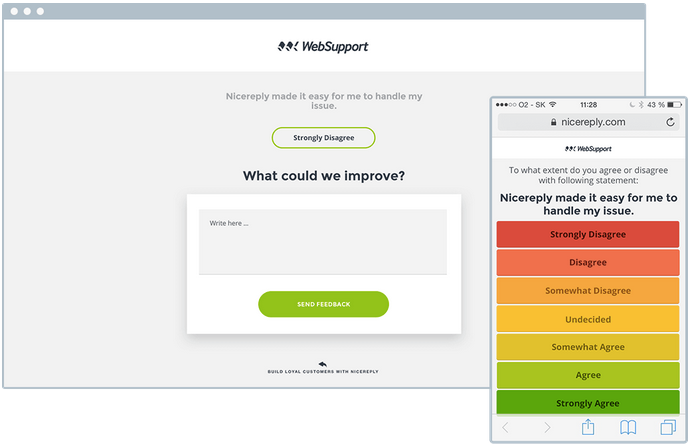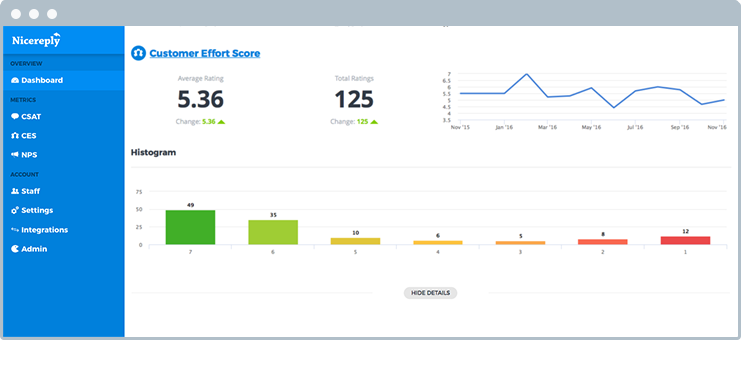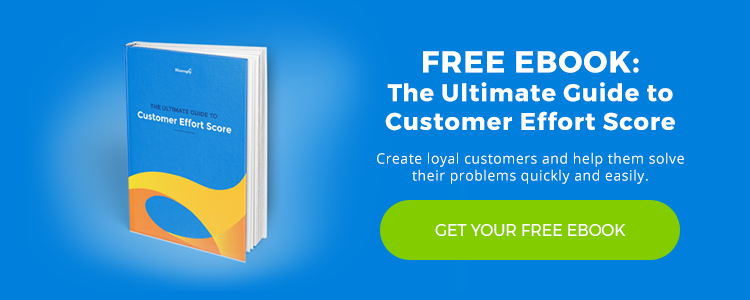As a keyed in customer service leader, you are constantly looking for ways to measure and improve customer experience. Perhaps you have heard of the CES metric, and are considering implementing Customer Effort Score for your team. Let’s talk about what it is, how it can improve your service offerings, and the steps to get you started with CES in your organization.
What is the CES?
We use the Customer Effort Score (CES) a metric in service interactions. It measures how easy it was for customers to get a resolution to their issue on a scale of very difficult (1) to very easy (7). CES is a transactional survey meaning that it pops up after each interaction resolution a customer has with a business. The underlying principle is that clients will stay with companies longer if it is easier to transact with them.
Read more about CES here.

Editor’s note: We use CES 2.0 – the newest iteration of CES – here at Nicereply. Previously, CES asked how much effort did you personally have to put forth to handle your request on a 5-point scale from very low effort (1) to very high effort (5).
Customers often faced difficulty interpreting the question and this skewed results. To simplify, we will use CES to refer to CES 2.0 throughout this article.
Why might you choose CES over CSAT?
How do you know which metric is right for you? To start, we need to ask why we track metrics at all. We could get a little existential: what’s the reason why we provide excellent service to our customers in the first place? Hopefully, good service leads to happy customers, and that leads to higher profits for the business. Measuring the right metrics should help you accomplish the end goal.

Measuring the right metrics is what CES seeks to improve over CSAT. The CEB found that CES is 1.8x more predictive of customer loyalty than CSAT and 2x more predictive than NPS. What does this mean? First of all, think about the last time you talked to a company. Maybe you had to report a product defect. Perhaps you had to pick up the phone and call, and then ship the broken item back. Even if you were happy with the customer service experience and marked the resolution as satisfactory, you are much less likely to do business with the company again. Remember all that hassle the last purchase caused?
More companies are recognizing it; being easy to do business with means that customer defections are rare. Customers will tend to stick with you long-term when you make it easy for them to do so.
Many support teams start implementing Customer Effort Score when they have learned all they can from CSAT. Once you consistently hit in the mid to high 90% with your CSAT scores, the amount of information you get from customers declines. Asking customers about the ease of service is also laser-focused on support experience. The insights you gain will be directly applicable to your team, and you will have full control over improving this metric.
Implementing Customer Effort Score
Are you ready to get started? There’s no big secret to implementing a Customer Effort Score program in your organization. Just converting your post-interaction survey to the CES 2.0 question will start delivering results instantly. There are a few tips that will superpower your CES experience, though, and they are worth thinking about before you start.
Tracking CES by channel
You will probably find that your CES varies the most by channel. Some companies are very easy to call for support, and some make live chat the most effortless experience. Customer Experience Futurologist, Dr. Nicola Millard, has found it is the best source of inspiration for her team at BT: “The great thing about [tracking by channel] is that it becomes very actionable then. For example, if IVR gets a rating of two, you can question whether it really works for customers.” Before cracking on with CES, ensure that the integration you use allows you to segment scores by channel, ticket ID, customer, product, agent, and any other information you track in your service interactions. You will need this information later to analyze results.
Integrating with other metrics
CES works best when blended with other methods of customer surveys. For example: measuring NPS over a customer lifetime can help pinpoint product issues and provide a more holistic view of how customers feel about your company. At some touch-points, CSAT may be high, but CES may be low. Varying your surveys will give you more actionable insight across different channels and situations. Unfortunately, survey fatigue is very real. If you are asking your customers for their opinions too often, you might see your response rate drop. Hence, plan out a schedule for surveys before launch to avoid overwhelming your customers.
Company-wide understanding
With any changes in how you measure customer experience, success is much more likely if you have the entire company on board. CES is definitely a more difficult metric to understand than CSAT, so we recommend doing a quick lunch-and-learn or sending around a team email on the subject. Educating others on why making the experience effortless makes good business sense will help you get buy-in on any projects you want to build as a result of the incoming information.
Reading the results
Analyze CES in two ways: as an average of all responses, and the distribution of responses.
CES takes all of the scores you receive and divides them by the total response number; it gives you a number between 1-7 that you want to keep pushing higher and higher. How? Well, by looking for ways how to make it easier and easier to do business with your company.

Possibly, it is more important to dig into the distribution of responses. Notice in the graph above that you have many customers who find it incredibly easy to do business with you; that’s great! Dig into their tickets to see what channels, what problems, and what strategies work well in creating that desired effortless experience.

However, you can see there’s a big chunk of customers who said it was tough to get a resolution to their issues. That’s where you’ll want to concentrate most of your focus on. Why is there a subset of customers who cannot easily resolve their question? Are they looking to accomplish a similar task? Are they contacting you through a particular channel? Maybe they speak a different language than you do business in! Regardless, the CES results give you a definite first step to improving your customer loyalty.

In general, you want to move all customers ratings to a 5 or above on the CES scale. The CEB study found that moving a client from 1 to 5 increases their loyalty (measured in return purchases and reduced churn) by 22%. Increasing from 5 to 7 offers a less dramatic return of 2% increase in loyalty.
Getting started with Nicereply
If you’re already a Nicereply customer, log into your account today to start implementing Customer Effort Score. If you’re not, we offer an easy integration with the major help desks (including Zendesk, Desk.com and Help Scout), so take us for a spin today!




